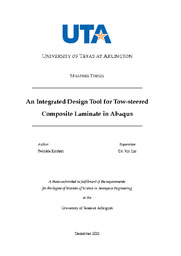
ATTENTION: The works hosted here are being migrated to a new repository that will consolidate resources, improve discoverability, and better show UTA's research impact on the global community. We will update authors as the migration progresses. Please see MavMatrix for more information.
Show simple item record
| dc.contributor.advisor | Liu, Xin | |
| dc.contributor.advisor | Raihan, Rassel | |
| dc.creator | Kothari, Twinkle | |
| dc.date.accessioned | 2023-01-26T16:15:40Z | |
| dc.date.available | 2023-01-26T16:15:40Z | |
| dc.date.created | 2022-12 | |
| dc.date.issued | 2023-01-02 | |
| dc.date.submitted | December 2022 | |
| dc.identifier.uri | http://hdl.handle.net/10106/31044 | |
| dc.description.abstract | The material of choice for contemporary aircraft and its component design over the past few decades has shifted more and more toward fiber-reinforced composites. This is mainly due to the improved strength, lightweight, corrosion resistance, design flexibility, and durability of composites over traditional metals. Advanced tailorable composites such as tow-steered composites can be designed and fabricated with fibers following prescribed curvilinear paths, which provides improved mechanical performance compared with unidirectional fiber-reinforced composites (UDFRCs). However, the potential of tow-steered composites oftentimes fails to be exploited due to the lack of design tools. Currently, there are no commercially available design tools for tow-steered composites and these advanced composite materials are often in off-optimal designs.
An integrated design tool for tow-steered composites is developed for commercial finite element (FE) software Abaqus via a graphical user interface (GUI) plug-in. This plug-in is written by Python scripts and incorporated all design definition setups so that users can design tow-steered composites in a unified environment within Abaqus. This design framework contains several components: design setups, multiscale plate modeling, FE structural analysis, and optimization. After the definition of design setups in the GUI plug-in, multiscale plate modeling is carried out by an external multiscale modeling code, which calculates the location-dependent shell stiffness matrix of each element in a FE model. The structural analysis with updated element properties can then be carried out by Abaqus. The optimization is performed by an external optimizer Dakota. The design variables are updated by Dakota and sent back to the FE model to compute structural responses to be employed in an objective function. Several examples are analyzed to demonstrate the use of the developed GUI plug-in.
This GUI plug-in provides a user-friendly and intuitive tool, which reduces the extra programming efforts of users so that they can focus on design innovations instead of code development. This work is supported through the Small Business Technology Transfer (STTR) program of the National Aeronautics and Space Administration (NASA). | |
| dc.format.mimetype | application/pdf | |
| dc.language.iso | en_US | |
| dc.subject | Tow-steered composites | |
| dc.subject | FEM | |
| dc.subject | Multi-scale modeling tool | |
| dc.title | An Integrated Design Tool for Tow-steered Composite Laminate in Abaqus | |
| dc.type | Thesis | |
| dc.date.updated | 2023-01-26T16:15:40Z | |
| thesis.degree.department | Mechanical and Aerospace Engineering | |
| thesis.degree.grantor | The University of Texas at Arlington | |
| thesis.degree.level | Masters | |
| thesis.degree.name | Master of Science in Aerospace Engineering | |
| dc.type.material | text | |
| dc.creator.orcid | 0000-0002-5266-2554 | |
Files in this item
- Name:
- KOTHARI-THESIS-2022.pdf
- Size:
- 6.068Mb
- Format:
- PDF
- Name:
- Thesis_7.zip
- Size:
- 15.39Mb
- Format:
- Unknown
- Name:
- Thesis_6.zip
- Size:
- 15.39Mb
- Format:
- Unknown
- Name:
- Thesis_5.zip
- Size:
- 15.39Mb
- Format:
- Unknown
- Name:
- Thesis_4.zip
- Size:
- 15.39Mb
- Format:
- Unknown
- Name:
- Thesis_3.zip
- Size:
- 15.39Mb
- Format:
- Unknown
- Name:
- Thesis_2.zip
- Size:
- 15.39Mb
- Format:
- Unknown
- Name:
- Thesis_1.zip
- Size:
- 15.39Mb
- Format:
- Unknown
- Name:
- Thesis.zip
- Size:
- 15.39Mb
- Format:
- Unknown
This item appears in the following Collection(s)
Show simple item record


